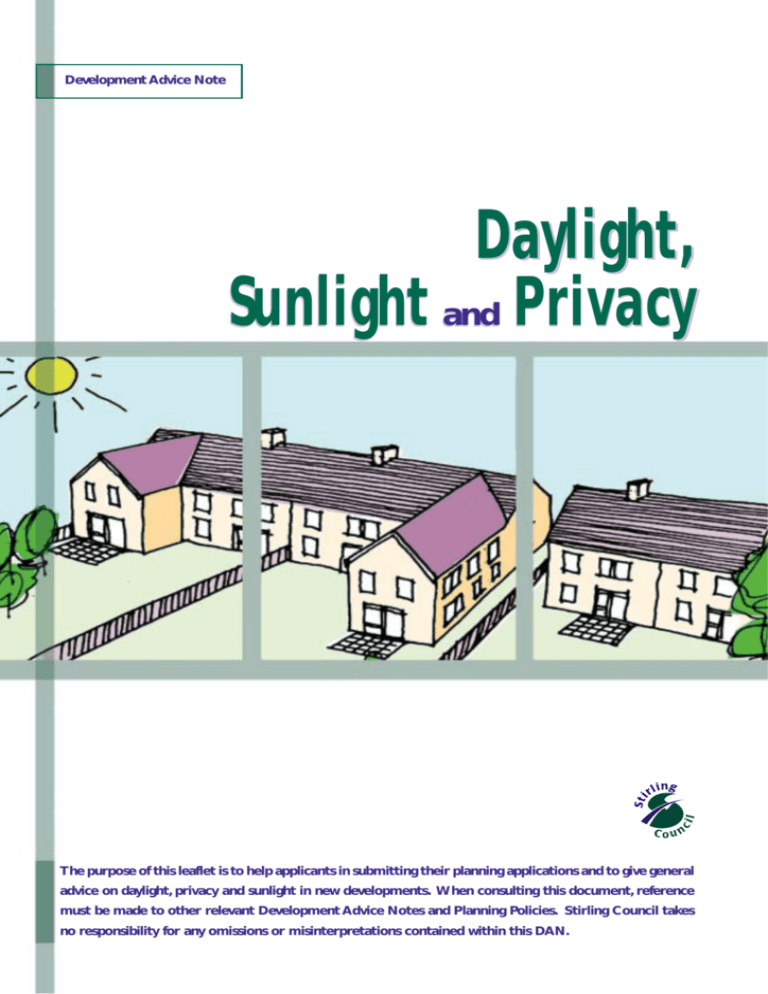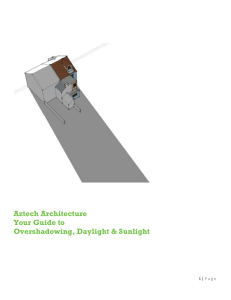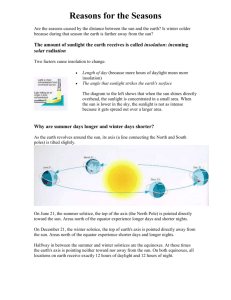Daylight, Sunlight and Privacy
advertisement

Development Advice Note Daylight, Sunlight and Privacy The purpose of this leaflet is to help applicants in submitting their planning applications and to give general advice on daylight, privacy and sunlight in new developments. When consulting this document, reference must be made to other relevant Development Advice Notes and Planning Policies. Stirling Council takes no responsibility for any omissions or misinterpretations contained within this DAN. 1 Daylight, Sunlight and Privacy Introduction The Building Research Establishment’s (BRE) guide “Site Layout Planning” sets out empirical guidelines and methods for assessing natural light. These standards apply essentially to new residential developments but may also be used for other types of development where ‘daylight’ is seen as an important issue eg in offices. Although built development is of particular concern throughout this DAN, the potential for existing and proposed trees to obstruct daylight and sunlight should also be considered. The methods of assessment set out in the BRE guide vary in complexity: some or all of these methods may be used, depending upon the specific circumstances of the development criteria. The approaches suggested are for guidance only and should not be used to dictate the form and layout of all development. In determining planning applications, a balance has to be sought between the reasonable expectations of homeowners to extend their property and the effect of that development on the locality. The Council’s DAN on ‘House Extensions’ and ‘The Layout and Design of New Housing Development’ are particularly relevant. The two approaches detailed below will therefore be applied with flexibility and at the discretion of the Council. The requirements of this guidance relate primarily to the main inhabited rooms such as living rooms, dining rooms and bedrooms and not to areas such as utility rooms, stairs, kitchens, toilets or to gardens with seating areas. What is the difference between sunlight and daylight? Daylight is the volume of natural light that enters a building to provide satisfactory illumination of internal accommodation between dawn and dusk. Daylight from an overcast sky is generally the same no matter how the building is orientated. Sunlight on the other hand refers to direct sunshine and is very much brighter than ambient daylight. ● The council will generally discourage extensions that would result in the loss of sunlight leading to overshadowing for the majority of the day. ● All buildings will be required to have adequate levels of daylight and this should be a priority for new developments. However some sunlight is also desirable but will not be a determining factor of new developments. A few helpful pointers to remember: ● The sun rises in the East and sets in the West. ● The sun reaches its maximum height around Noon and will be due South at this time. ● The sun is a lot higher in the Summer than the Winter and days are longer. ● In Scotland, the sun elevation in mid-Winter does not generally rise above 10 degrees and therefore casts long shadows. Daylight, Sunlight and Privacy Protecting existing daylight house extensions & new buildings ● New buildings or extensions should be designed to minimise the overshadowing of neighbouring properties. ● It will be expected that the greater part of any overshadowing caused by a new building should be confined to the applicant’s own land. The major factors that will affect the amount of overshadowing are height, distance to boundary, size of plot, orientation and topography. The following BRE guidelines should be followed: m et re s+ Diagram 1 12 2 45˚ midpoint of window permissable if distance to two storey extension on 45˚ line is more extension than 12 metres, code is not applicable 45˚ 45˚ 45˚ midpoint of window furthest point from window extension has no significant overshadowing extension may have overshadowing effect permissable single storey extension 45 degree approach A useful guideline to measure the likely impact of an extension or new building on your neighbour is the “45 degree’’ approach. The purpose of this is to make sure that a development does not take away too much daylight. It is based upon the notion that it is reasonable to expect a certain level of light and unobstructed view from a habitable room window. To comply with the approach, no part of a two storey development should cross the line drawn at a 45 degree angle from the centre of the closest ground floor habitable room window of neighbouring properties. (See diagrams 1 and 2.) This guide is more relaxed in relation to single storey development where the 45 degree line is drawn from the furthest point away from the closest ground floor habitable room window of neighbouring properties. In both these cases, where the length of the line would exceed 12 metres before reaching any part of the proposed development, the 45 degree approach need not apply. Proposed Extension 45˚ Existing Building 45˚ Diagram 2 Proposed Extension A significant amount of light is likely to be blocked if the centre of the window on the existing building lies within the 45˚ lines on both elevation and plan. 3 Daylight, Sunlight and Privacy 25 degree approach This approach should be utilised when the new development directly faces the affected window. Suitable daylight for habitable rooms is achieved when a 25 degree vertical angle taken from the centre of the lowest window is kept unobstructed (see diagram 3). The recommended distance between the buildings is dependent on the opposing property ridge height. If the building opposite has a high ridge, the loss of daylight will be more notable than if the building has a lower ridge height. If the proposed development fails the test, further investigation and evidence may be required in order to assess whether an unacceptable loss of sunlight/daylight will occur. Diagram 3 Protection of Existing Buildings Not Acceptable Acceptable Existing Building Proposed Building t eigh eh idg r um xim Ma 25˚ centre of lowest window Sunlight for new development ● Where possible, and consistent with other policies and guidelines, new buildings including new flats and housing, should be constructed to take advantage of sunlight to provide a pleasant living environment and to maximise solar gain. ● Although it would be unreasonable to require that all dwellings have sunlit rooms, single aspect dwellings which are sited so that every habitable room is facing due north and have amenity areas which are usually in shade, may not be acceptable. 4 Daylight, Sunlight and Privacy Privacy and overlooking for residential developments In general, a minimum 18 metre distance for privacy should be established between windows of habitable rooms that are parallel to each other. The guiding principle is that housing should be suitably orientated and spaced, and the window suitably placed to prevent any direct overlooking of habitable rooms and areas from neighbouring dwellings. (See diagram 4.) In the case of single storey extensions, conservatories and decking, overlooking and/or loss of privacy may be influenced by local conditions such as topography and existing planting or screening. Diagram 4 The erection of timber decking or other structure ‘incidental to the enjoyment of the overlooking dwelling house’ may require planning permission if it is around 3 metres in height. To clarify whether planning consent will be required early contact should be made with Stirling Council Planning Authority. In planning such developments, careful consideration must be given to issues of privacy and overlooking (in relation to neighbouring windows) particularly if the structure is detached from the main building and/or elevated. Diagram 5 Raised decking can cause overlooking and an unacceptable loss of privacy Its appearance and design must be appropriate to the character of surrounding properties and gardens. Sloping sites can cause particular problems. (See diagram 5.) Loss of privacy and overlooking can be minimised by: ● considering the position of windows and their possible removal or relocation; ● keeping the need for any additional new openings to a minimum and using opaque glazing or high level windows as appropriate; ● giving careful thought to internal room arrangements and how the room will be used; ● siting external staircases, terraces or balconies with care; ● improving boundary treatment/screening and landscaping while also considering their impact on daylight and sunlight; and ● siting vehicular access roads and parking areas with care. Contact Environment Services Stirling Council,Viewforth, Stirling FK8 2ET Tel: (01786) 442515 Fax: (01786) 443003 Email: planning @stirling.gov.uk References and useful reading ● Building Research Establishment Site Layout Planning for daylight and sunlight: a good practice guide, 1991 ● Stirling Council House Extension Development Advice Note, 2000 ● Stirling Council Layout and Design of New Housing Development and Advice Note, 2002 Designed and produced by Stirling Council’s Communications Unit April 2004. Printed by Stirling Reprographics. Web: www.stirling.gov.uk








